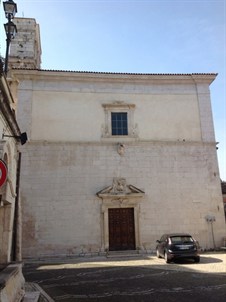Bugnara
 At the border with the city of Sulmona, Bugnara is a town inhabited by a little over a thousand people, which appears in the list of the borghi più belli d’Italia (most beautiful towns in Italy). As in the case of Sulmona, the face of the town was severely affected by the repeated seismic events but in spite of this it still conserves evident traces of Baroque art which has almost completely disappeared from other zones of the Abruzzo region. The church of the Madonna del Rosario was reopened for religious services in December 2000 after a long phase of restoration which gave it back many aspects and characteristics which had been lost for centuries. In particular, the decorative compositions executed between the end of the seventeenth and the beginning of the eighteenth centuries, thus restoring the church’s Baroque appearance. This constitutes a further proof of the presence in Abruzzo of artists and masters from other regions of Italy, especially Naples, Rome and Lombardy. The decorative composition is characterised by this mix of styles and influences to which can be added the merit of being one of the few complexes from the first years of the eighteenth century which have survived natural disasters, especially earthquakes and the numerous attempts to superimpose different styles which became popular in the following centuries. Particularly significant is the main altar, an eloquent example of Baroque art which displays the evident influence of Bernini, of the seventeenth century Roman Baroque, but also of Cosimo Fanzago, who is present, as will be seen, in the context of Pescocostanzo. The touch of the Lombard master is visible in other details such as the figures in relief, rare in Abruzzo but normal in Central European contexts on pillars and imposts of the altars.
At the border with the city of Sulmona, Bugnara is a town inhabited by a little over a thousand people, which appears in the list of the borghi più belli d’Italia (most beautiful towns in Italy). As in the case of Sulmona, the face of the town was severely affected by the repeated seismic events but in spite of this it still conserves evident traces of Baroque art which has almost completely disappeared from other zones of the Abruzzo region. The church of the Madonna del Rosario was reopened for religious services in December 2000 after a long phase of restoration which gave it back many aspects and characteristics which had been lost for centuries. In particular, the decorative compositions executed between the end of the seventeenth and the beginning of the eighteenth centuries, thus restoring the church’s Baroque appearance. This constitutes a further proof of the presence in Abruzzo of artists and masters from other regions of Italy, especially Naples, Rome and Lombardy. The decorative composition is characterised by this mix of styles and influences to which can be added the merit of being one of the few complexes from the first years of the eighteenth century which have survived natural disasters, especially earthquakes and the numerous attempts to superimpose different styles which became popular in the following centuries. Particularly significant is the main altar, an eloquent example of Baroque art which displays the evident influence of Bernini, of the seventeenth century Roman Baroque, but also of Cosimo Fanzago, who is present, as will be seen, in the context of Pescocostanzo. The touch of the Lombard master is visible in other details such as the figures in relief, rare in Abruzzo but normal in Central European contexts on pillars and imposts of the altars.
